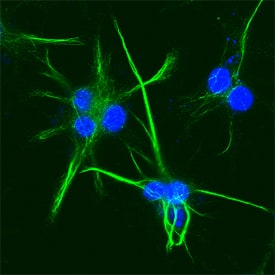Human Cytokeratin 18 Alexa Fluor® 488-conjugated Antibody
R&D Systems, part of Bio-Techne | Catalog # IC7619G


Key Product Details
Species Reactivity
Applications
Label
Antibody Source
Product Specifications
Immunogen
Ala239-Asp397
Accession # P05783
Specificity
Clonality
Host
Isotype
Scientific Data Images for Human Cytokeratin 18 Alexa Fluor® 488-conjugated Antibody
Cytokeratin 18 in HeLa Human Cell Line.
Cytokeratin 18 was detected in formaldehyde fixed HeLa human cervical epithelial carcinoma cell line using Mouse Anti-Human Cytokeratin 18 Alexa Fluor® 488‑conjugated Monoclonal Antibody (Catalog # IC7619G) at 1:10 dilution overnight at 4 °C and counterstained with DAPI (blue). Specific staining was localized to intermediate filaments. View our protocol for Fluorescent ICC Staining of Cells on Coverslips.Applications for Human Cytokeratin 18 Alexa Fluor® 488-conjugated Antibody
Immunocytochemistry
Sample: Formaldehyde fixed HeLa human cervical epithelial carcinoma cell line
Formulation, Preparation, and Storage
Purification
Formulation
Shipping
Stability & Storage
- 12 months from date of receipt, 2 to 8 °C as supplied.
Background: Cytokeratin 18
Cytokeratin 18; also known as KRT-18 (Keratin, type I cytoskeletal 18), Cell proliferation-inducing gene 46 and Keratin-18) is a 44-48 kDa Class I (large keratins of acidic pH) member of the intermediate filament family of proteins. Individual keratins are always expressed in tandem with a second keratin, and these are found in all epithelial cells. The class I Cytokeratin 18 heterodimerizes/polymerizes with 50-52 kDa class II KRT-8 to form 8-10 nm filaments in single strata plus hepatic epithelia. Cytokeratin 18 and -8 are the first keratins to appear in the mammalian embyro. In the adult, Cytokeratin 18 appears to participate in subtractions and additions to the plasma membrane. In this regard, a number of intracellular proteins interact with Cytokeratin 18, including 14-3-3, HSPc70 and Mrj. Cytokeratin 18 may also be O‑glycosylated, and when so, serves to promote Akt-1 activity, thus protecting against apoptosis. Human Cytokeratin 18 is 430 amino acids (aa) in length. It contains an N-terminal "head" region (aa 1-79), a subsequent "rod" region (aa 80-387) with two coiled segments, and a C-terminal tail region. Cytokeratin 18 possesses at least 19 utilized phosphorylation sites plus five acetylated Lys residues. There are multiple isoforms that range from 20-40 kDa in size and are the result of caspase cleavage. A principal cleavage site occurs after Asp238. Over aa 239-397, human Cytokeratin 18 shares 86% aa sequence identity with mouse Cytokeratin 18.
Alternate Names
Gene Symbol
UniProt
Additional Cytokeratin 18 Products
Product Specific Notices for Human Cytokeratin 18 Alexa Fluor® 488-conjugated Antibody
This product is provided under an agreement between Life Technologies Corporation and R&D Systems, Inc, and the manufacture, use, sale or import of this product is subject to one or more US patents and corresponding non-US equivalents, owned by Life Technologies Corporation and its affiliates. The purchase of this product conveys to the buyer the non-transferable right to use the purchased amount of the product and components of the product only in research conducted by the buyer (whether the buyer is an academic or for-profit entity). The sale of this product is expressly conditioned on the buyer not using the product or its components (1) in manufacturing; (2) to provide a service, information, or data to an unaffiliated third party for payment; (3) for therapeutic, diagnostic or prophylactic purposes; (4) to resell, sell, or otherwise transfer this product or its components to any third party, or for any other commercial purpose. Life Technologies Corporation will not assert a claim against the buyer of the infringement of the above patents based on the manufacture, use or sale of a commercial product developed in research by the buyer in which this product or its components was employed, provided that neither this product nor any of its components was used in the manufacture of such product. For information on purchasing a license to this product for purposes other than research, contact Life Technologies Corporation, Cell Analysis Business Unit, Business Development, 29851 Willow Creek Road, Eugene, OR 97402, Tel: (541) 465-8300. Fax: (541) 335-0354.
For research use only